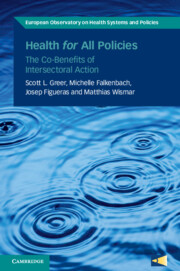Contents
1From Health in All Policies to Health for All Policies: the logic of co-benefits
5SDG1, eliminating poverty: improvements to health coverage design as a means to create co-benefits between health system and poverty Sustainable Development Goals
6SDG4, education: education as a lever for sustainable development
8SDG8, promoting decent work and economic growth: health policies for good jobs
9SDG9, industry, innovation and infrastructure: technology and knowledge transfer as means to generate co-benefits between health and industrial Sustainable Development Goals
10SDG10, reduced inequalities: the effect of health policy on inequalities: evidence from South Africa
11SDG11, sustainable cities and communities: making cities healthy, sustainable, inclusive and resilient through strong health governance
12SDG13, climate action: health systems as stakeholders and implementors in climate policy change
Appendix Case study: climate-driven health hazards – natural disasters
13SDG17, means of implementation: strengthen the means of implementation and revitalize the Global Partnership for Sustainable Development

